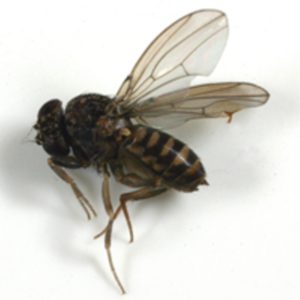
The fruit fly is one of the indoor flies described and discussed in the new publication. (Texas A&M AgriLife Extension Service photo by Dr. Mike Merchant)
By: Paul Schattenberg, Texas A&M AgriLife Communications
DALLAS – It’s getting close to fly season again and a new Texas A&M AgriLife Extension Service publication will help people identify different types of indoor flies, understand their biology and, most importantly, learn how to eliminate them.
“Next to ants, flies may be the most common household pest problem,” said Dr. Mike Merchant, AgriLife Extension entomologist in Dallas. Merchant is the author of the new six-page fact sheet “Indoor Flies and Their Control,” which provides pictures, descriptions and behavioral details on the most common indoor flies.
While some flies come in when we open the door, many of the flies referred to in this publication live naturally in the home,” Merchant said. “Fruit flies are small enough to get in through window screens. Other flies live in sewer lines. And others can find their way in by digging through the soil under our homes. Once indoors, if we give them the right conditions to live, these flies can become permanent residents.”
Merchant said indoor flies are opportunists and control is most effective when breeding sites within a structure are identified and eliminated.
“Give flies a chance to get inside and a place to breed and they’ll be all over the place just like, well, flies,” he said.
Merchant said smaller house-infesting flies include drain flies, fruit flies, phorid flies and fungus gnats. Larger flies, such as blowflies and flesh flies, occasionally invade homes to lay eggs, but rarely infest homes for long.
“House flies and mosquitoes rarely breed inside structures; however, they readily take advantage of open doors or unscreened windows to get indoors for food or shelter,” he said.
Merchant said dealing with fly breeding sites is much easier when people know what kind of fly is driving them crazy.
“All flies are not alike,” Merchant said. “Knowing what kind of fly you are dealing with is 90 percent of solving your fly problem.”
He said the new publication explains fly types and biology, how to identify potential sources of infestations and shows how to control and prevent infestation. The publication, which is identified as ENTO-050, is free and available as an electronic download. It can be found at http://bit.ly/1TAbenx .
“Indoor flies are common problem in homes and businesses and insecticides alone are rarely successful in eliminating them,” he said. “Because each type of indoor fly prefers slightly different breeding sites, identifying the fly should be the first step in any control effort. By far the best way to rid your home or business of flies is to find and eliminate breeding hot spots.”
Merchant said breeding hot spots include trash receptacles, especially the wet bottoms of trash cans when plastic liners have leaked; bags of vegetables, such as potatoes or onions, left in pantries; damaged or overripe fruits left out of the refrigerator; vegetable debris; open or loose lids on vinegar, wine, beer or cider containers; recycling bins with unrinsed drink containers; damp, dirty mops, brooms or cleaning rags; kitchen floor crevices, floor drains and areas around plumbing leaks; and moist rotting or fermenting organic matter.
“When it comes to flies, we’ve all been trained to reach for the spray can,” Merchant said. “But insecticide fogs and sprays provide, at best, only temporary control of indoor flies.”
He said there should be little or no need to use insecticides once fly-breeding areas are cleaned or eliminated, but they can still be helpful in ridding homes of existing adult flies and control flies entering from other locations.
Merchant said pyrethrin aerosol sprays or other “flying insect” sprays can provide temporary control of adult flies indoors.
“For outdoor fly problems, a residual insecticide labeled for outdoor fly control can be applied to fly resting sites,” he said. “When mosquitoes or house flies are common outdoors, spray door entryways with one of these insecticides to reduce the number of flies that are likely to enter the house along with human traffic.”
He said those using insecticides should be sure to follow label directions carefully, as many insecticide labels now prohibit spraying pavement, surfaces exposed to rain or surfaces that drain onto pavement.
“The goal of these precautions is to prevent insecticides from being washed into streams or storm drains,” he said. “In some cases, commercial baits are available for controlling house flies. Bait formulations include products that can be used in bait stations or applied as a liquid or slurry to areas where flies land.”
Merchant said some baits can be toxic to pets or livestock, so following label safety instructions is imperative.
“Flies sometimes carry disease and can be a real nuisance, so anyone trying to achieve a fly-free indoors should check out this new publication,” Merchant said. “With summer coming, fly problems will be increasing, so I think this publication is coming out at just the right time.”